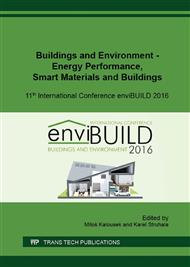p.469
p.477
p.485
p.493
p.501
p.509
p.519
p.527
p.537
The Implications of Assumed Boundary Conditions for the Reliability of Indoor Illuminance Predictions: A Case Study
Abstract:
In order to model daylight availability and distribution in architectural spaces, simulation tools require reliable representations of boundary conditions – typically in terms of sky luminance distribution models. However, the impact of sky model errors on simulation-based indoor illuminance predictions is not well documented. There are different tools and methods to simulate indoor illuminance conditions and related daylight indicators. In the present study, we selected Radiance lighting simulation program. In order to generate sky scene description, Radiance contains two routines, namely, Gendaylit and Gensky. These routines require, as input, information on both direct and diffuse components of solar radiation. To explore the implications of the sky model selection on the fidelity of simulation results, we used Radiance to compute the indoor illuminance in an existing test space on the rooftop of a university building. Thereby, the aforementioned two sky models were considered. A third option (SC) was a sky model generated based on measured values obtained from a sky scanner. Simultaneously, the actual illuminance levels in this room were monitored under different outdoor conditions (clear, intermediate, overcast). The comparison of the measurement results with multiple model prediction results facilitates an empirically based evaluation of the reliability of indoor illuminance predictions in the face of different assumptions pertaining to the prevailing boundary conditions.
Info:
Periodical:
Pages:
501-508
Citation:
Online since:
December 2016
Authors:
Price:
Сopyright:
© 2017 Trans Tech Publications Ltd. All Rights Reserved
Share:
Citation:


